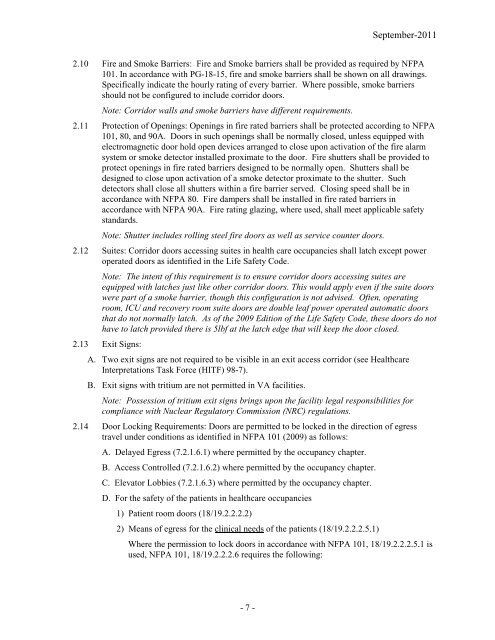Fire Protection Design Manual - Office of Construction and Facilities ...
Fire Protection Design Manual - Office of Construction and Facilities ...
Fire Protection Design Manual - Office of Construction and Facilities ...
Create successful ePaper yourself
Turn your PDF publications into a flip-book with our unique Google optimized e-Paper software.
September-2011<br />
2.10 <strong>Fire</strong> <strong>and</strong> Smoke Barriers: <strong>Fire</strong> <strong>and</strong> Smoke barriers shall be provided as required by NFPA<br />
101. In accordance with PG-18-15, fire <strong>and</strong> smoke barriers shall be shown on all drawings.<br />
Specifically indicate the hourly rating <strong>of</strong> every barrier. Where possible, smoke barriers<br />
should not be configured to include corridor doors.<br />
Note: Corridor walls <strong>and</strong> smoke barriers have different requirements.<br />
2.11 <strong>Protection</strong> <strong>of</strong> Openings: Openings in fire rated barriers shall be protected according to NFPA<br />
101, 80, <strong>and</strong> 90A. Doors in such openings shall be normally closed, unless equipped with<br />
electromagnetic door hold open devices arranged to close upon activation <strong>of</strong> the fire alarm<br />
system or smoke detector installed proximate to the door. <strong>Fire</strong> shutters shall be provided to<br />
protect openings in fire rated barriers designed to be normally open. Shutters shall be<br />
designed to close upon activation <strong>of</strong> a smoke detector proximate to the shutter. Such<br />
detectors shall close all shutters within a fire barrier served. Closing speed shall be in<br />
accordance with NFPA 80. <strong>Fire</strong> dampers shall be installed in fire rated barriers in<br />
accordance with NFPA 90A. <strong>Fire</strong> rating glazing, where used, shall meet applicable safety<br />
st<strong>and</strong>ards.<br />
Note: Shutter includes rolling steel fire doors as well as service counter doors.<br />
2.12 Suites: Corridor doors accessing suites in health care occupancies shall latch except power<br />
operated doors as identified in the Life Safety Code.<br />
Note: The intent <strong>of</strong> this requirement is to ensure corridor doors accessing suites are<br />
equipped with latches just like other corridor doors. This would apply even if the suite doors<br />
were part <strong>of</strong> a smoke barrier, though this configuration is not advised. Often, operating<br />
room, ICU <strong>and</strong> recovery room suite doors are double leaf power operated automatic doors<br />
that do not normally latch. As <strong>of</strong> the 2009 Edition <strong>of</strong> the Life Safety Code, these doors do not<br />
have to latch provided there is 5lbf at the latch edge that will keep the door closed.<br />
2.13 Exit Signs:<br />
A. Two exit signs are not required to be visible in an exit access corridor (see Healthcare<br />
Interpretations Task Force (HITF) 98-7).<br />
B. Exit signs with tritium are not permitted in VA facilities.<br />
Note: Possession <strong>of</strong> tritium exit signs brings upon the facility legal responsibilities for<br />
compliance with Nuclear Regulatory Commission (NRC) regulations.<br />
2.14 Door Locking Requirements: Doors are permitted to be locked in the direction <strong>of</strong> egress<br />
travel under conditions as identified in NFPA 101 (2009) as follows:<br />
A. Delayed Egress (7.2.1.6.1) where permitted by the occupancy chapter.<br />
B. Access Controlled (7.2.1.6.2) where permitted by the occupancy chapter.<br />
C. Elevator Lobbies (7.2.1.6.3) where permitted by the occupancy chapter.<br />
D. For the safety <strong>of</strong> the patients in healthcare occupancies<br />
1) Patient room doors (18/19.2.2.2.2)<br />
2) Means <strong>of</strong> egress for the clinical needs <strong>of</strong> the patients (18/19.2.2.2.5.1)<br />
Where the permission to lock doors in accordance with NFPA 101, 18/19.2.2.2.5.1 is<br />
used, NFPA 101, 18/19.2.2.2.6 requires the following:<br />
- 7

















